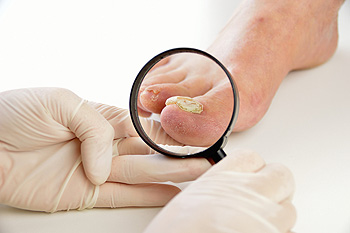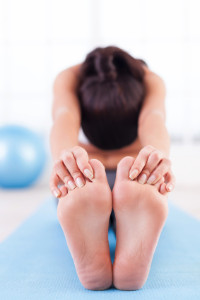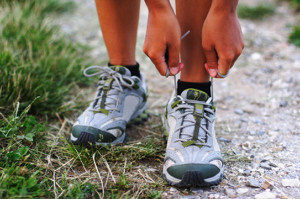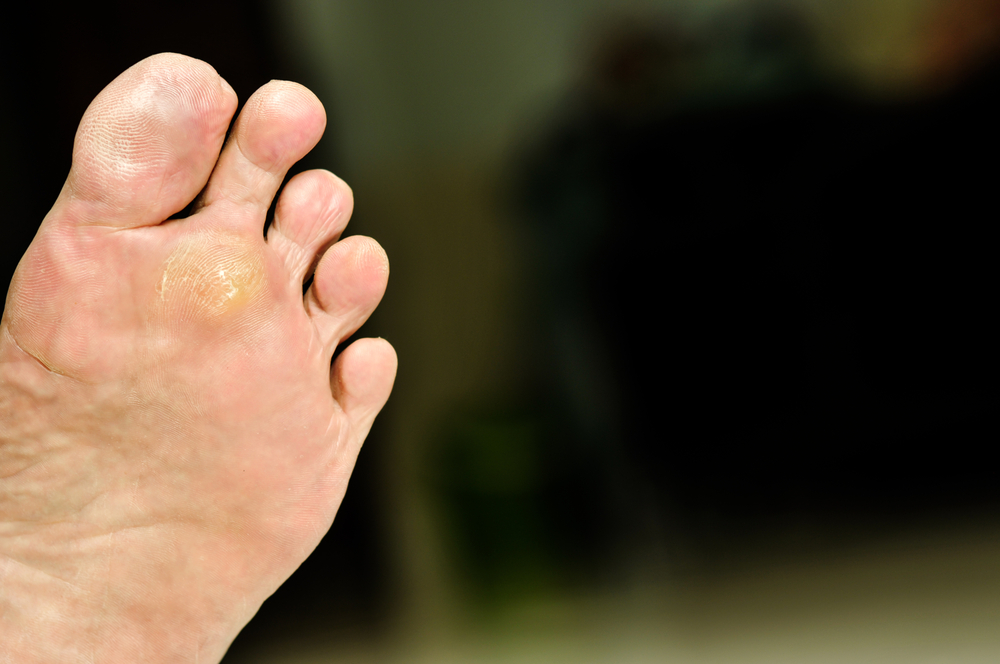Items filtered by date: August 2020
Fungal Nails 101
 When fungus gets under the toenail, it begins to feed on the keratin that makes up the nail. While an infected nail is easy to treat in the early stages, the infection becomes more and more difficult to manage as it grows. Common risk factors for developing a fungal nail infection may include trauma, poor hygiene, sweating, and walking barefoot in moist environments. Toenails that have been infected by a fungus will become brittle, crumble, and turn yellowish in color. Treatments for infected toenails can include topical medications, oral medications, and laser treatment. If you believe that you are afflicted with a toenail fungus, it is important that you consult with a podiatrist for proper care and treatment.
When fungus gets under the toenail, it begins to feed on the keratin that makes up the nail. While an infected nail is easy to treat in the early stages, the infection becomes more and more difficult to manage as it grows. Common risk factors for developing a fungal nail infection may include trauma, poor hygiene, sweating, and walking barefoot in moist environments. Toenails that have been infected by a fungus will become brittle, crumble, and turn yellowish in color. Treatments for infected toenails can include topical medications, oral medications, and laser treatment. If you believe that you are afflicted with a toenail fungus, it is important that you consult with a podiatrist for proper care and treatment.
For more information about treatment, contact one of our podiatrists of Sayville Foot Care. Our doctors can provide the care you need to keep you pain-free and on your feet.
Toenail Fungus Treatment
Toenail fungus is a condition that affects many people and can be especially hard to get rid of. Fortunately, there are several methods to go about treating and avoiding it.
Antifungals & Deterrence
Oral antifungal medicine has been shown to be effective in many cases. It is important to consult with a podiatrist to determine the proper regiment for you, or potentially explore other options.
Applying foot powder on the feet and shoes helps keep the feet free of moisture and sweat.
Sandals or open toed shoes – Wearing these will allow air movement and help keep feet dry. They also expose your feet to light, which fungus cannot tolerate. Socks with moisture wicking material also help as well.
If you have any questions please feel free to contact our office located in Sayville, NY . We offer the newest diagnostic tools and technology to treat your foot and ankle needs.
Where Did This Foot Blister Come From?
 Blisters are small, fluid-filled bumps on the skin that form in response to trauma. The most common cause of blisters on the feet are shoes rubbing repeatedly against the skin. However, there are a variety of other reasons you may have developed a blister. These can include burns or sunburns, frostbite, eczema, allergic reactions, exposure to poison ivy, viruses that cause chicken pox or cold sores, and various diseases or infections. If you have a foot blister and can’t pinpoint the cause, or if your blister is draining pus, red in color, warm or painful, or if you have a fever, diabetes, or circulatory problems, it is strongly recommended that you visit a podiatrist. A podiatrist can examine and treat blisters on the feet and provide the appropriate treatment.
Blisters are small, fluid-filled bumps on the skin that form in response to trauma. The most common cause of blisters on the feet are shoes rubbing repeatedly against the skin. However, there are a variety of other reasons you may have developed a blister. These can include burns or sunburns, frostbite, eczema, allergic reactions, exposure to poison ivy, viruses that cause chicken pox or cold sores, and various diseases or infections. If you have a foot blister and can’t pinpoint the cause, or if your blister is draining pus, red in color, warm or painful, or if you have a fever, diabetes, or circulatory problems, it is strongly recommended that you visit a podiatrist. A podiatrist can examine and treat blisters on the feet and provide the appropriate treatment.
Blisters are prone to making everyday activities extremely uncomfortable. If your feet are hurting, contact one of our podiatrists of Sayville Foot Care. Our doctors can provide the care you need to keep you pain-free and on your feet.
Foot Blisters
Foot blisters develop as a result of constantly wearing tight or ill-fitting footwear. This happens due to the constant rubbing from the shoe, which can often lead to pain.
What Are Foot Blisters?
A foot blister is a small fluid-filled pocket that forms on the upper-most layer of the skin. Blisters are filled with clear fluid and can lead to blood drainage or pus if the area becomes infected.
How Do Blisters Form?
Blisters on the feet are often the result of constant friction of skin and material, usually by shoe rubbing. Walking in sandals, boots, or shoes that don’t fit properly for long periods of time can result in a blister. Having consistent foot moisture and humidity can easily lead to blister formation.
Prevention & Treatment
It is important to properly care for the affected area in order to prevent infection and ease the pain. Do not lance the blister and use a Band-Aid to provide pain relief. Also, be sure to keep your feet dry and wear proper fitting shoes. If you see blood or pus in a blister, seek assistance from a podiatrist.
If you have any questions, please feel free to contact our office located in Sayville, NY . We offer the newest diagnostic and treatment technologies for all your foot care needs.
Where Do Plantar Warts Develop?
A growth on the sole of the foot may indicate a plantar wart. A plantar wart is described as a small, thick patch of skin that grows into the bottom of the foot. This happens as a result of the constant pressure the feet endure by walking, standing, and running. This type of wart is caused by a virus that is known as the human papillomavirus (HPV), and is considered to be contagious. Common symptoms that are often seen with plantar warts can include severe pain and discomfort while walking, and the wart may have small black dots in the center, which is dried blood. There are a variety of methods to treat plantar warts, consisting of applying salicylic acid directly on the wart, utilizing cryotherapy, or other forms of medicine. If you have developed this type of wart, it is suggested that you consult with a podiatrist who can effectively treat plantar warts.
Plantar warts can be very uncomfortable. If you need your feet checked, contact one of our podiatrists from Sayville Foot Care. Our doctors will assist you with all of your foot and ankle needs.
About Plantar Warts
Plantar warts are the result of HPV, or human papillomavirus, getting into open wounds on the feet. They are mostly found on the heels or balls of the feet.
While plantar warts are generally harmless, those experiencing excessive pain or those suffering from diabetes or a compromised immune system require immediate medical care. Plantar warts are easily diagnosed, usually through scraping off a bit of rough skin or by getting a biopsy.
Symptoms
- Lesions on the bottom of your feet, usually rough and grainy
- Hard or thick callused spots
- Wart seeds, which are small clotted blood vessels that look like little black spots
- Pain, discomfort, or tenderness of your feet when walking or standing
Treatment
- Freezing
- Electric tool removal
- Laser Treatment
- Topical Creams (prescription only)
- Over-the-counter medications
To help prevent developing plantar warts, avoid walking barefoot over abrasive surfaces that can cause cuts or wounds for HPV to get into. Avoiding direct contact with other warts, as well as not picking or rubbing existing warts, can help prevent the further spread of plantar warts. However, if you think you have developed plantar warts, speak to your podiatrist. He or she can diagnose the warts on your feet and recommend the appropriate treatment options.
If you have any questions please feel free to contact our office located in Sayville, NY . We offer the newest diagnostic and treatment technologies for all your foot and ankle needs.
Stretching to Reduce Heel Pain
 Plantar fasciitis, a condition in which the plantar fascia ligament that runs along the bottom of your foot becomes inflamed, is one of the most common causes of heel pain among adults. Fortunately, something as simple as stretching your feet can help prevent plantar fasciitis, all while increasing the strength and flexibility of your feet. One easy stretch that you can do in the comfort of your own home is the Water Bottle Stretch. To do this stretch, sit down in a chair and place a water bottle, tennis ball, or rolling pin on the floor in front of you. Slowly roll the bottom of your foot over the object, starting from the ball of your foot and moving back towards the heel. Do this for about a minute, and then repeat on the other foot. If you are using a water bottle, you may also freeze it prior to doing this stretch. The cold water bottle will then simultaneously stretch and ice your foot, reducing pain and inflammation. For more information on how you can prevent plantar fascia injuries and for treatment options for plantar fasciitis, consult with a podiatrist today.
Plantar fasciitis, a condition in which the plantar fascia ligament that runs along the bottom of your foot becomes inflamed, is one of the most common causes of heel pain among adults. Fortunately, something as simple as stretching your feet can help prevent plantar fasciitis, all while increasing the strength and flexibility of your feet. One easy stretch that you can do in the comfort of your own home is the Water Bottle Stretch. To do this stretch, sit down in a chair and place a water bottle, tennis ball, or rolling pin on the floor in front of you. Slowly roll the bottom of your foot over the object, starting from the ball of your foot and moving back towards the heel. Do this for about a minute, and then repeat on the other foot. If you are using a water bottle, you may also freeze it prior to doing this stretch. The cold water bottle will then simultaneously stretch and ice your foot, reducing pain and inflammation. For more information on how you can prevent plantar fascia injuries and for treatment options for plantar fasciitis, consult with a podiatrist today.
Why Stretching Is Important for Your Feet
Stretching the feet is a great way to prevent injuries. If you have any concerns with your feet consult with one of our podiatrists from Sayville Foot Care. Our doctors will assess your condition and provide you with quality foot and ankle treatment.
Stretching the Feet
Stretching the muscles in the foot is an important part in any physical activity. Feet that are tight can lead to less flexibility and make you more prone to injury. One of the most common forms of foot pain, plantar fasciitis, can be stretched out to help ease the pain. Stretching can not only ease pain from plantar fasciitis but also prevent it as well. However, it is important to see a podiatrist first to determine if stretching is right for you. Podiatrists can also recommend other ways to stretch your feet. Once you know whether stretching is right for you, here are some excellent stretches you can do.
- Using a foam roller or any cylindrical object (a water bottle or soda can will do), roll the object under your foot back and forth. You should also exert pressure on the object. Be sure to do this to both feet for a minute. Do this exercise three times each.
- Similar to the previous exercise, take a ball, such as a tennis ball, and roll it under your foot while seated and exert pressure on it.
- Grab a resistance band or towel and take a seat. If you are using a towel, fold it length wise. Next put either one between the ball of your foot and heel and pull with both hands on each side towards you. Hold this for 15 seconds and then switch feet. Do this three times for each foot.
- Finally hold your big toe while crossing one leg over the other. Pull the toe towards you and hold for 15 seconds. Once again do this three times per foot.
It is best to go easy when first stretching your foot and work your way up. If your foot starts hurting, stop exercising to ice and rest the foot. It is advised that you then see a podiatrist for help.
If you have any questions, please feel free to contact our office located in Sayville, NY . We offer the newest diagnostic and treatment technologies for all your foot care needs.
Wounds That Don't Heal Need to Be Checked
Running Shoes Can Be Made of Different Materials
 Research has indicated the best time to purchase running shoes is at the end of the day. The feet have a tendency to be larger at this time of the day, and this may be a result of the foot expanding as daily activities are pursued. It is beneficial to try running shoes on before they are purchased, and it is helpful to run on a treadmill, which may be available in specific stores. Shoes that fit properly will feel good at the time they are tried on, and may not have to be broken in. Shoes that are constructed with mesh materials typically have more room and flexibility than shoes that are made of hard plastic. If you would like additional information about buying running shoes, it is suggested that you schedule a consultation with a podiatrist.
Research has indicated the best time to purchase running shoes is at the end of the day. The feet have a tendency to be larger at this time of the day, and this may be a result of the foot expanding as daily activities are pursued. It is beneficial to try running shoes on before they are purchased, and it is helpful to run on a treadmill, which may be available in specific stores. Shoes that fit properly will feel good at the time they are tried on, and may not have to be broken in. Shoes that are constructed with mesh materials typically have more room and flexibility than shoes that are made of hard plastic. If you would like additional information about buying running shoes, it is suggested that you schedule a consultation with a podiatrist.
If you are a runner, wearing the right running shoe is essential. For more information, contact one of our podiatrists from Sayville Foot Care. Our doctors can provide the care you need to keep you pain-free and on your feet.
Choosing the Right Running Shoe for Your Foot Type
To increase performance and avoid the risk of injury, it is important to choose the right running shoe based on your foot type. The general design of running shoes revolves around pronation, which is how the ankle rolls from outside to inside when the foot strikes the ground.
- Neutral runners are able to choose from a wide variety of shoes, including minimalist shoes or even going barefoot.
- Runners who overpronate, or experience an over-abundance of ankle rolling, should choose shoes that provide extra motion control and stability.
- Runners who underpronate, or supinate, have feet that have high arches and lack flexibility, preventing shock absorption. They require shoes with more flexibility and cushion.
If you have any questions please feel free to contact our office located in Sayville, NY . We offer the newest diagnostic and treatment technologies for all your foot and ankle needs.


